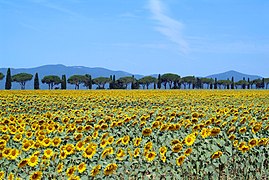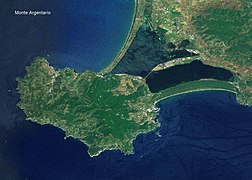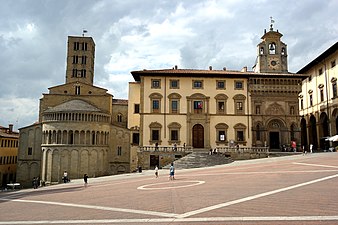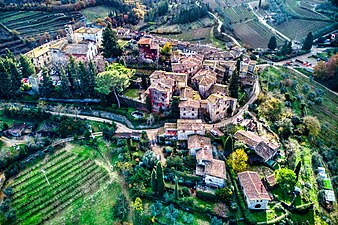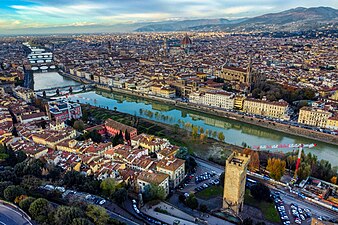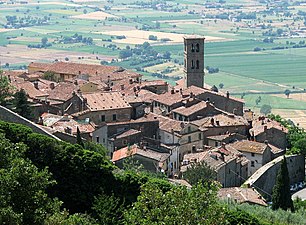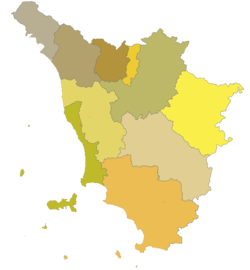Tuscany
Tuscany
| ||
|---|---|---|
|
ISO 3166 code IT-52 | | |
| HDI (2021) | 0.909[4] very high • 6th of 21 | |
| NUTS Region | ITI1 | |
| Website | www | |
Tuscany (/ˈtʌskəni/ TUSK-ə-nee, Italian: Toscana, Italian: [toˈskaːna]) is a region in central Italy with an area of about 23,000 square kilometres (8,900 square miles) and a population of about 3.8 million inhabitants. The regional capital is Florence (Firenze).
Tuscany is known for its landscapes, history, artistic legacy, and its influence on high culture. It is regarded as the birthplace of the Italian Renaissance[5] and of the foundations of the Italian language. The prestige established by the Tuscan dialect's use in literature by Dante Alighieri, Petrarch, Giovanni Boccaccio, Niccolò Machiavelli and Francesco Guicciardini led to its subsequent elaboration as the language of culture throughout Italy.[6] It has been home to many figures influential in the history of art and science, and contains well-known museums such as the Uffizi and the Palazzo Pitti. Tuscany is also known for its wines, including Chianti, Vino Nobile di Montepulciano, Morellino di Scansano, Brunello di Montalcino and white Vernaccia di San Gimignano. Having a strong linguistic and cultural identity, it is sometimes considered "a nation within a nation".[7]
Tuscany is the second-most-popular Italian region for travellers in Italy, after Veneto.[8] The main tourist spots are Florence, Castiglione della Pescaia, Pisa, San Gimignano, Lucca, Grosseto and Siena.[9] The town of Castiglione della Pescaia is the most visited seaside destination in the region,[9] with seaside tourism accounting for approximately 40% of tourist arrivals. The Maremma region, Siena, Lucca, the Chianti region, Versilia and Val d'Orcia are also internationally renowned and particularly popular spots among travellers.
Eight Tuscan localities have been designated
Geography

- A: Im > 200
- B: 80 < Im < 100
- B1-B2: 20 < Im < 80
- C2: 0 < Im < 20
- C1: −33,3 < Im < 0
- D: Im < −33,3
Roughly triangular in shape, Tuscany borders the regions of Liguria to the northwest, Emilia-Romagna to the north, Marche and Umbria to the east, and Lazio to the south and southeast. The comune (municipality) of Badia Tedalda, in the Tuscan Province of Arezzo, has an exclave named Ca' Raffaello within Emilia-Romagna.
Tuscany has a western coastline on the Ligurian Sea and the Tyrrhenian Sea, among which is the Tuscan Archipelago, of which the most significant island is Elba. Tuscany has an area of approximately 22,993 square kilometres (8,878 sq mi). Surrounded and crossed by major mountain chains and with few (but fertile) plains, the region has a relief that is dominated by hilly country used for agriculture. Hills make up nearly two-thirds (66.5%) of the region's total area, covering 15,292 square kilometres (5,904 sq mi), and mountains (of which the highest are the Apennines), a further 25%, or 5,770 square kilometres (2,230 sq mi). Plains occupy 8.4% of the total area—1,930 square kilometres (750 sq mi)—mainly around the valley of the Arno. Many of Tuscany's most significant cities lie on the banks of the Arno, including the capital, Florence, Empoli, and Pisa.
The climate is fairly mild in the coastal areas, and is harsher and rainy in the interior, with considerable fluctuations in temperature between winter and summer,[11] giving the region a soil-building active freeze-thaw cycle, in part accounting for the region once having served as a key breadbasket of ancient Rome.[12]
-
Typical landscape of the Val d'Orcia
-
Sunflower field near Castiglione della Pescaia, Maremma
-
A view of the Chianti countryside
-
Balze di Volterra
-
Fallow deer in the Padule di Bolgheri
-
Arno river in Casentino
-
Hilly landscape in Val d'Orcia
History
Apennine, Proto-Villanovan and Villanovan culture
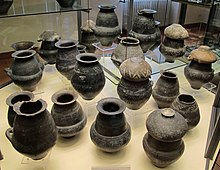
The pre-Etruscan history of the area in the middle and late
Etruscans
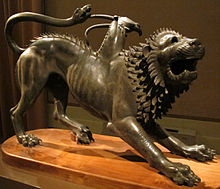
The Etruscans (Latin: Tusci) created the first major civilization in this region, large enough to establish a transport infrastructure, to implement agriculture and mining and to produce vibrant art.[17] The Etruscans lived in the area of Etruria well into prehistory.[13] The civilization grew to fill the area between the Arno and Tiber from the tenth century BCE, reaching its peak during the seventh and sixth centuries B.C., finally succumbing to the Romans by the first century BCE.[18] From the Etruscans, Tuscany took the name of Etruria, Tuscia for the Romans and subsequently Tuscania and Tuscany. While the areas of north-western Tuscany were inhabited by the ancient Ligures. In northwestern Tuscany, the area between the Arno and Magra rivers was culturally aligned with the Etruscans in the early Iron Age, and came under Ligurian control in the late Iron Age.[19]
One reason for the eventual demise of this civilization was the increasing absorption by surrounding cultures, including the adoption of the Etruscan upper class by the Romans.[17][18]
Romans
Soon after absorbing Etruria (to the north, northeast, east, and a strip to the south), Rome established the cities of Lucca, Pisa, Siena, and Florence, endowed the area with new technologies and development, and ensured peace.[17] These developments included extensions of existing roads, the introduction of aqueducts and sewers, and the construction of many buildings, both public and private. However, many of these structures have been destroyed by erosion due to weather.[17]
The Roman civilization in the West of the
Medieval period

One family that benefitted from Florence's growing wealth and power was the ruling
The
-
A page from Fibonacci's Liber Abaci (1202)
-
Battle of Giglio(1241)
-
Dante Alighieri, author of the Divine Comedy
Renaissance
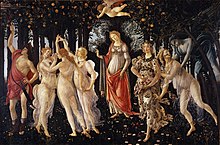
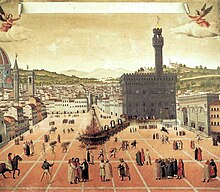
Tuscany, especially Florence, is regarded as the birthplace of the Renaissance. Though "Tuscany" remained a linguistic, cultural, and geographic conception rather than a political reality, in the 15th century, Florence extended its dominion in Tuscany through the annexation of Arezzo in 1384, the purchase of Pisa in 1405, and the suppression of a local resistance there (1406). Livorno was bought in 1421 and became the harbour of Florence.
From the leading city of Florence, the republic was from 1434 onward dominated by the increasingly monarchical
The Sienese commune was not incorporated into Tuscany until 1555, and during the 15th century, Siena enjoyed a cultural 'Sienese Renaissance' with its own more conservative character. Lucca remained an independent republic until 1847 when it became part of Grand Duchy of Tuscany by the will of its people. Piombino and other strategic towns constituted the tiny State of the Presidi under Spanish control.
-
Niccolò Machiavelli, author of The Prince
Modern era

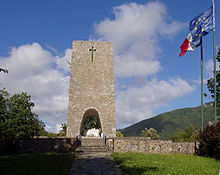
In the 16th century, the
Under Benito Mussolini, the area came under the dominance of local Fascist leaders such as Dino Perrone Compagni (from Florence), and Costanzo and Galeazzo Ciano (from Livorno). Following the fall of Mussolini and the armistice of 8 September 1943, Tuscany became part of the Nazi-controlled Italian Social Republic and was conquered almost totally by the Anglo-American forces during the summer of 1944.
Following the end of the Social Republic and the transition from the Kingdom to the modern Italian Republic, Tuscany once more flourished as a cultural centre of Italy. Since the establishment of the regional government in 1970, Tuscany has always been ruled by centre-left governments.
-
Cosimo I de' Medici, first Grand Duke of Tuscany
-
Pinocchio, created by Carlo Collodi (1883)
-
An Italian partisan in Florence (1944)
Culture
Tuscany has an immense cultural and artistic heritage, expressed in the region's churches, palaces, art galleries, museums, villages, and piazzas. Many of these artifacts are found in the main cities, such as Florence and Siena, but also in smaller villages scattered around the region, such as San Gimignano.
Art

Tuscany has a unique artistic legacy, and Florence is one of the world's most important water-colour centres, even so that it is often nicknamed the "art palace of Italy" (the region is also believed to have the largest concentration of Renaissance art and architecture in the world).
The region contains numerous museums and art galleries, many housing some of the world's most precious works of art. Such museums include the
Art schools

In the medieval period and the Renaissance, four main Tuscan art schools competed against each other: the
- The Florentine School refers to artists in, from, or influenced by the .
- The Sienese School of painting flourished in Beccafumi and Il Sodomaworked there. While Baldassare Peruzzi was born and trained in Siena, his major works and style reflect his long career in Rome. The economic and political decline of Siena by the 16th century, and its eventual subjugation by Florence, largely checked the development of Sienese painting, although it also meant that many Sienese works in churches and public buildings were not discarded or destroyed by new paintings or rebuilding. Siena remains a remarkably well-preserved Italian late-Medieval town.
- The Lucchese School, also known as the School of Lucca and as the Pisan-Lucchese School, was a school of painting and sculpture that flourished in the 11th and 12th centuries in the western and southern part of the region, with an important centre in Volterra. The art is mostly anonymous. Although not as elegant or delicate as the Florentine School, Lucchese works are remarkable for their monumentality.
Main artistic centres
In the province of Arezzo:
In the province of Florence:
In the Province of Grosseto:
In the province of Livorno:
In the province of Lucca:
In the
- Massa and Carrara
- Pontremoli
- Fivizzano
- Fosdinovo
In the province of Pisa:
In the province of Pistoia:
In the province of Prato:
In the province of Siena:
Language
Apart from standard
Music
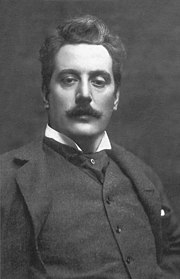
Tuscany has a rich ancient and modern musical tradition, and has produced numerous composers and musicians, including Giacomo Puccini and Pietro Mascagni. Florence is the main musical centre of Tuscany. The city was at the heart of much of the Western musical tradition. It was there that the Florentine Camerata convened in the mid-16th century and experimented with setting tales of Greek mythology to music and staging, resulting in the first operas, fostering the further development of the operatic form, and the later developments of separate "classical" forms such as the symphony.
There are numerous musical centres in Tuscany.
Literature

Several famous writers and poets are from Tuscany, most notably Florentine author Dante Alighieri. Tuscany's literary scene particularly thrived in the 13th century and the Renaissance.
In Tuscany, especially in the Middle Ages, popular love poetry existed. A school of imitators of the Sicilians was led by
Another type of poetry also began in Tuscany. Guittone d'Arezzo made art abandon chivalry and Provençal forms for national motives and Latin forms. He attempted political poetry, and although his work is often obscure, he prepared the way for the Bolognese school. Bologna was the city of science, and philosophical poetry appeared there. Guido Guinizelli was the poet after the new fashion of the art. In his work, the ideas of chivalry are changed and enlarged. Only those whose heart is pure can be blessed with true love, regardless of class. He refuted the traditional credo of courtly love, for which love is a subtle philosophy only a few chosen knights and princesses could grasp. Love is blind to blasons but not to a good heart when it finds one: when it succeeds it is the result of the spiritual, not physical affinity between two souls. Guinizzelli's democratic view can be better understood in the light of the greater equality and freedom enjoyed by the city-states of the center-north and the rise of a middle class eager to legitimise itself in the eyes of the old nobility, still regarded with respect and admiration but dispossessed of its political power.[citation needed]
Guinizelli's Canzoni make up the bible of Dolce Stil Novo, and one in particular, "Al cor gentil" ("To a Kind Heart") is considered[by whom?] the manifesto of the new movement which would bloom in Florence under Cavalcanti, Dante and their followers. His poetry has some of the faults of the school of d'Arezzo. Nevertheless, he marks a great development in the history of Italian art, especially because of his close connection with Dante's lyric poetry.
In the 13th century, there were several major allegorical poems. One of these is by Brunetto Latini, who was a close friend of Dante. His Tesoretto is a short poem, in seven-syllable verses, rhyming in couplets, in which the author professes to be lost in a wilderness and to meet with a lady, who represents Nature, from whom he receives much instruction. We see here the vision, the allegory, the instruction with a moral object, three elements which we shall find again in the Divine Comedy. Francesco da Barberino, a learned lawyer who was secretary to bishops, a judge, and a notary, wrote two little allegorical poems, the Documenti d'amore and Del reggimento e dei costumi delle donne. The poems today are generally studied not as literature, but for historical context. A fourth allegorical work was the Intelligenza, which is sometimes attributed to Compagni but is probably only a translation of French poems.[30]
In the 15th century, humanist and publisher Aldus Manutius published the Tuscan poets Petrarch and Dante Alighieri (Divine Comedy), creating the model for what became a standard for modern Italian.
Cuisine

Simplicity is central to the
Wine is a famous and common produce of Tuscany. The red wine Chianti is perhaps the most well-known internationally. Due to the many British tourists who come to the area where Chianti wine is produced this specific area has been nicknamed "Chiantishire".
Postage stamps
Between 1851 and 1860, the
Economy
The gross domestic product (GDP) of the region was 117.5 billion euros in 2018, accounting for 6.7% of Italy's economic output. GDP per capita adjusted for purchasing power was 31,400 euros or 104% of the EU27 average in the same year. The GDP per employee was 106% of the EU average.[32]
Unemployment rate
The unemployment rate stood at 7.3% in 2018 and was slightly lower than the national average.[33][34]
| Year | 2006 | 2007 | 2008 | 2009 | 2010 | 2011 | 2012 | 2013 | 2014 | 2015 | 2016 | 2017 | 2018 | 2019 |
|---|---|---|---|---|---|---|---|---|---|---|---|---|---|---|
| unemployment rate (in %) |
4.8% | 4.4% | 5.0% | 5.8% | 6.0% | 6.3% | 7.8% | 8.7% | 10.1% | 9.2% | 9.5% | 8.6% | 7.3% | 6.7% |
Agriculture

The subsoil in Tuscany is relatively rich in mineral resources, with iron ore, copper, mercury, and lignite mines, the famous soffioni (fumarole) at Larderello, and the vast marble mines in Versilia. Although its share is falling all the time, agriculture still contributes to the region's economy. In the region's inland areas cereals, potatoes, olives, and grapes are grown. The swamplands, which used to be marshy, now produce vegetables, rice, tobacco, beets, and sunflowers.[11]
Industry
One of the traditional foundations of the industrial sector is mining, given the abundance of underground resources. Also of note are textiles and clothing, chemicals and pharmaceuticals, steel and metalworking, glass and ceramics, and printing and publishing. Smaller areas specialising in manufacturing and craft industries are found in the hinterland: the leather and footwear area in the south-west part of the province of Florence, the hot-house plant area in Pistoia, the ceramics and textile industries in the Prato area, scooters, and motorcycles in Pontedera, and the processing of timber for the manufacture of wooden furniture in the Cascina area. The heavy industries (mining, steel, and mechanical engineering) are concentrated along the coastal strip (Livorno and Pisa areas), where there are also important chemical industries. Also of note are the marble (Carrara area) and paper industries (Lucca area).[11]
Tourism
In Tuscany 80% of tourism demand is concentrated in cities of art and seaside resorts, the rest is divided between the countryside, hills, and mountains. In 2019 the municipalities with the relatively higher percentage of presences, in descending order, are:
Tuscany has many small and picturesque villages, 29 of them have been selected by I Borghi più belli d'Italia (English: The most beautiful Villages of Italy),[36] a non-profit private association of small Italian towns of strong historical and artistic interest,[37] that was founded on the initiative of the Tourism Council of the National Association of Italian Municipalities.[38]
Fashion

The fashion and textile industry are the pillars of the Florentine economy. In the 15th century, Florentines were working with luxury textiles such as wool and silk. Today the greatest designers in Europe utilize the textile industry in Tuscany, and especially Florence. A large plant of production is happening in the town of Prato.
Italy has one of the strongest textile industries in Europe, accounting for approximately one-quarter of European production. Its turnover is over 25 billion euros. It is the third largest supplier of clothing after China and Japan. The Italian fashion industry generates 60% of its turnover abroad.[39]
Demographics
| Year | Pop. | ±% |
|---|---|---|
| 1861 | 1,920,000 | — |
| 1871 | 2,124,000 | +10.6% |
| 1881 | 2,187,000 | +3.0% |
| 1901 | 2,503,000 | +14.4% |
| 1911 | 2,670,000 | +6.7% |
| 1921 | 2,810,000 | +5.2% |
| 1931 | 2,914,000 | +3.7% |
| 1936 | 2,978,000 | +2.2% |
| 1951 | 3,158,811 | +6.1% |
| 1961 | 3,286,160 | +4.0% |
| 1971 | 3,473,097 | +5.7% |
| 1981 | 3,581,051 | +3.1% |
| 1991 | 3,529,946 | −1.4% |
| 2001 | 3,497,806 | −0.9% |
| 2011 | 3,672,202 | +5.0% |
| 2021 | 3,663,191 | −0.2% |
| Source: ISTAT 2011 | ||
The population density of Tuscany, with 161 inhabitants per square kilometre (420/sq mi) in 2008, is below the national average (198.8/km2 or 515/sq mi). This is due to the low population density of the provinces of Arezzo, Siena, and especially Grosseto (50/km2 or 130/sq mi). The highest density is found in the province of Prato (675/km2 or 1,750/sq mi), followed by the provinces of Pistoia, Livorno, Florence and Lucca, peaking in the cities of Florence (more than 3,500/km2 or 9,100/sq mi), Livorno, Prato, Viareggio, Forte dei Marmi and Montecatini Terme (all with a population density of more than 1,000/km2 or 2,600/sq mi). The territorial distribution of the population is closely linked to the socio-cultural and, more recently, economic and industrial development of Tuscany.[11]
Accordingly, the least densely populated areas are those where the main activity is agriculture, unlike the others where, despite the presence of several large industrial complexes, the main activities are connected with tourism and associated services, alongside many small firms in the leather, glass, paper and clothing sectors.[11]
Italians make up 93% of the total population. Starting from the 1980s, the region has attracted a large flux of immigrants, particularly from China, Romania, Albania and Morocco. There is also a significant community of British and American residents. As of 2008[update], the Italian national institute of statistics ISTAT estimated that 275,149 foreign-born immigrants live in Tuscany, equal to 7% of the total regional population.
Government and politics
The
Tuscany is a stronghold of the centre-left
Administrative divisions
Tuscany is divided into nine provinces and one Metropolitan City:
| Province | Area (km2) | Population | Density (inhabitants/km2) |
|---|---|---|---|
| Province of Arezzo | 3,232 | 345,547 | 106.9 |
| Metropolitan City of Florence | 3,514 | 983,073 | 279.8 |
| Province of Grosseto | 4,504 | 225,142 | 50.0 |
| Province of Livorno | 1,218 | 340,387 | 279.4 |
| Province of Lucca | 1,773 | 389,495 | 219.7 |
Province of Massa and Carrara
|
1,157 | 203,449 | 175.8 |
| Province of Pisa | 2,448 | 409,251 | 167.2 |
| Province of Pistoia | 965 | 289,886 | 300.4 |
| Province of Prato | 365 | 246,307 | 674.8 |
| Province of Siena | 3,821 | 268,706 | 81.9 |
See also
- Cities and towns in Tuscany
- List of municipalities of Tuscany
- Tuscan Archipelago
- People from Tuscany
- Neoclassical architecture in Tuscany
References
Citations
- ^ "Statistiche demografiche ISTAT". demo.istat.it. Archived from the original on 18 July 2020. Retrieved 9 October 2020.
- ^ "Statistiche demografiche ISTAT". Archived from the original on 22 February 2021. Retrieved 10 March 2010.
- ^ "Population on 1 January by age, sex and NUTS 2 region", www.ec.europa.eu
- ^ "Sub-national HDI - Area Database - Global Data Lab". hdi.globaldatalab.org. Retrieved 5 March 2023.
- ^ Burke, P., The European Renaissance: Centre and Peripheries (1998).
- ^ "storia della lingua in 'Enciclopedia dell'Italiano'". Treccani.it. Retrieved 28 October 2017.
- ^ Hewlett, Maurice Henry (1904). "The road in Tuscany: a commentary". Macmillan Publishers.
- ^ "Le sei regioni italiane più visitate. La top 20 europea". www.rainews.it (in Italian). 10 July 2014. Retrieved 15 December 2020.
- ^ a b "La Maremma regina del turismo. Solo le città d'arte la superano. Castiglione presenze record". 8 October 2015.
- ^ "Top 100 City Destinations: 2019 Edition". Euromonitor International. Retrieved 17 December 2020.
- ^ a b c d e "TOSCANA - Geography and history". Archived from the original on 21 July 2011. Retrieved 9 March 2011. Text finalised in March 2004 - Eurostat.
- ^ Military Channel (Discovery Network) documentary series Rome: Power and Glory, episode "The Grasp of an Empire", copyright unknown, rebroadcast 11-12:00 hrs EDST, 29 June 2009.
- ^ a b c d Barker & Rasmussen 2000, p. 5.
- ISBN 9788878145337.
Il termine "Villanoviano" è entrato nella letteratura archeologica quando, a metà dell '800, il conte Gozzadini mise in luce le prime tombe ad incinerazione nella sua proprietà di Villanova di Castenaso, in località Caselle (BO). La cultura villanoviana coincide con il periodo più antico della civiltà etrusca, in particolare durante i secoli IX e VIII a.C. e i termini di Villanoviano I, II e III, utilizzati dagli archeologi per scandire le fasi evolutive, costituiscono partizioni convenzionali della prima età del Ferro.
- ISBN 9788843022618.
- ISBN 9780199547913.
- ^ a b c d e f g h i Jones 2005, p. 2
- ^ a b Barker & Rasmussen 2000, p. 1.
- ISBN 978-1614515203.
- ^ a b Jones 2005, p. 3
- ISBN 978-0-8160-6935-4.
- ISBN 0-85115-943-5.
- ^ "The Economic Impact of the Black Death". EH.Net. Archived from the original on 13 March 2010.
- ^ Snell, Melissa (2006). "The Great Mortality". About.com Education. Archived from the original on 10 March 2009. Retrieved 19 April 2009.
- ^ Cipolla, Carlo M. (1981). Fighting the Plague in Seventeenth Century Italy. Madison: University of Wisconsin Press.
- ^ Miner, Jennifer (2 September 2008). "Florence Art Tours, Florence Museums, Florence Architecture". Travelguide.affordabletours.com. Archived from the original on 29 January 2010. Retrieved 18 April 2010.
- ^ "Florentine Art and Architecture". Annenberg Learner. Retrieved 28 January 2016.
- ^ Renaissance Artists "Artists of the Italian Renaissance". Archived from the original on 24 November 2010. Retrieved 28 September 2010.
- ISBN 0-8020-4424-7. Retrieved 5 May 2022.
- ^ Granacki, Alyssa. Duke University. Brunetto Latini, Tesoretto. Retrieved 24 August 2020.
- ^ Piras, 221-239.[clarification needed]
- ^ "Regional GDP per capita ranged from 30% to 263% of the EU average in 2018". Eurostat.
- ^ "Unemployment rate by NUTS 2 regions". ec.europa.eu. Eurostat. Retrieved 19 September 2019.
- ^ "Tasso di disoccupazione - livello regionale". dati.istat.it (in Italian). Retrieved 19 September 2019.
- ^ Regional Statistical Office of the Tuscany Region, Tuscany region (12 September 2019). "Tuscany between accommodation supply and demand: summary data 2019". Tuscany region (in Italian). Retrieved 20 July 2022.
- ^ "Toscana" (in Italian). 5 December 2016. Retrieved 1 August 2023.
- ^ "Borghi più belli d'Italia. Le 14 novità 2023, dal Trentino alla Calabria" (in Italian). 16 January 2023. Retrieved 28 July 2023.
- ^ "I Borghi più belli d'Italia, la guida online ai piccoli centri dell'Italia nascosta" (in Italian). Retrieved 3 May 2018.
- ^ [1] Archived 2 February 2009 at the Wayback Machine
Sources
- ISBN 0-631-22038-0.
- Jones, Emma (2005). Adventure Guide Tuscany & Umbria. ISBN 1-58843-399-4.
External links
 Geographic data related to Tuscany at OpenStreetMap
Geographic data related to Tuscany at OpenStreetMap- Official website of the Tuscany Region (in Italian)
- Tuscany official tourism website


